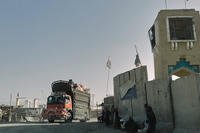Three Marine Corps installations in North Carolina suffered catastrophic damage during Hurricane Florence, requiring billions of dollars in repairs so forces there can remain ready to respond to the nation's crises.
Last year's late-summer hurricane hovered over the East Coast for days, dumping up to three feet of rain in some areas. It left in its wake $3.8 billion in damages to facilities and housing at Camp Lejeune and Marine Corps Air Stations New River and Cherry Point, Brig. Gen. Benjamin Watson, head of Marine Corps Installations East, said Friday.
Between the three bases, 800 buildings and 4,000 houses were damaged by the deadly storm. Watson called the destruction a "gut punch" for the service and said it could have serious implications for national security.
The bases are host to II Marine Expeditionary Force, which makes up a third of the Corps.
Having installations from which Marines are called on to deploy in disrepair could leave the country vulnerable, Watson said.
"We just can't afford to be inoperable or unable to accomplish our mission as America's 911 force," he told local leaders and community members during a forum about the storm's aftermath.
Florence forced the Marine Corps to delay several of its deployments and East Coast training missions.
"A couple of the railroad trestles were destroyed, which has made the railroad unable to handle the traffic we need in order to deploy forces from [the East Coast]," Watson said.
The damage to base facilities left 3,000 service members displaced, he added, and 4,000 military families suffered varying levels of destruction to their on-base housing. Those homes are now in the process of being rebuilt or repaired, but when families are in limbo, Watson said it distracts Marines from their mission.
"What allows them to be successful is the fact that we have the facilities, people and resources to prepare them for what they do when they go overseas in the service of our nation," he said. "What allows them to focus while they are overseas is the collective effort we put as a community into taking care of their families while they're gone."
Much of the infrastructure damaged in the storms were old buildings the Marine Corps had been "putting Band-Aids on for years," Watson said.
Many are now uninhabitable and need to be torn down and rebuilt to withstand future storms -- because they're coming, he said.
"We're only about six months out from the next hurricane season," Watson said. "That's scary."
The Marine Corps needs support from leaders at the state and national level as it requests the $3.8 billion for repairs.
"Our resilience kind of works against us in some ways," Watson said. "As military members ... [we] are resilient. But we need help here to get well from last year's storms."
-- Gina Harkins can be reached at gina.harkins@military.com. Follow her on Twitter @ginaaharkins.













